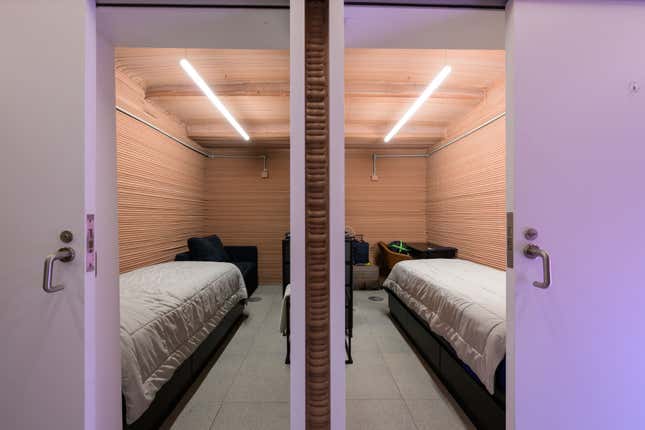On Sunday, four researchers donned black jumpsuits and entered into a red world where they will spend a year living and working in a simulated Martian environment.
Is Google’s New $1,800 Pixel Phone Worth It? | Gizmodo Review
NASA’s CHAPEA habitat, or Crew Health and Performance Exploration Analog, welcomed its volunteer guests this week, who are set to spend 378 days in the enclosed, Mars-like world to help the space agency prepare for future missions to the Red Planet.
“I feel incredibly lucky and blessed to be a part of this crew and the mission,” research scientist Kelly Haston, one of the four participants in the ongoing study, said during a press briefing before entering the habitat. “It is a career and personal highlight to be both scientist and test subject and produce data that may enable new methods and safer space travel.”
Hatson, along with structural engineer Ross Brockwell, emergency medicine physician Nathan Jones, and U.S. Navy microbiologist Anca Selariu, were selected in April for the study. NASA had sent out a call for volunteers in 2021 for “healthy, motivated” U.S. citizens between the ages of 30 to 55 to take part in the first of three year-long missions.
The 3D-printed, 1,700-square-foot habitat is located at NASA’s Johnson Space Center in Houston, Texas. It has a kitchen, two bathrooms, private bedrooms, a work area, as well as a recreational area for socializing.
“The habitat will simulate the challenges of a mission on Mars, including resource limitations, equipment failure, communication delays, and other environmental stressors,” NASA wrote in a statement.
Inside the simulated Martian environment, the four volunteers will carry out different activities as though they were on a mission to Mars, including simulated spacewalks, robotic operations, habitat maintenance, personal hygiene, exercise, and crop growth.
“The analog is critical for testing solutions to meet the complex needs of living on the Martian surface,” Grace Douglas, lead scientist for NASA’s Advanced Food Technology research effort at NASA’s Johnson Space Center in Houston, said in a statement. “Simulations on Earth will help us understand and counter the physical and mental challenges astronauts will face before they go.”

NASA, with the help of its international partners, eventually hopes to send humans to Mars and possibly establish a sustainable presence of astronauts in habitats on Earth’s neighboring planet. Mars is a dry, arid desert with a thin, carbon-dioxide-filled atmosphere and freezing temperatures during its winter season. Those other-worldly factors are likely to make astronauts’ time on Mars a little rough, which is why the space agency wants to be prepared for the challenges ahead.
“The simulation will allow us to collect cognitive and physical performance data to give us more insight into the potential impacts of long-duration missions to Mars on crew health and performance,” Douglas said. “Ultimately, this information will help NASA make informed decisions to design and plan for a successful human mission to Mars.”
For more spaceflight in your life, follow us on Twitter and bookmark Gizmodo’s dedicated Spaceflight page.
Đất Trái Động luôn là điều mọi người đang muốn nhưng chưa thực hiện được. Một nhóm bốn tình nguyện viên quyết định làm điều họ đã lập trước – họ khóa chính mình trong một phòng ở giả lập trên sao Hỏa trong một năm.
Theo nhóm, họ là những nhà khoa học với bề dày kinh nghiệm trong học thuật, kỹ thuật, y khoa và thực hành NASA. Họ nguyện vọng rằng sẽ có một sự khám phá lớn làm thay đổi những gì chúng ta hiểu về cuộc sống trong không gian và việc phục vụ nhu cầu con người.
Trong chuyến thăm dò của nhóm, họ đã phải đối mặt với nhiều thách thức của trọng tâm. Các thí nghiệm đã bao gồm lập luận và tên truyền thông trong nhóm, giám sát chăm sóc của tế bào, giữ trình độ cố định tinh thần, cải thiện kiến thức công nghệ và định hướng không gian trong nơi ở của họ.
Nhóm cố gắng đi qua những thách thức khó khăn này và sống trong một nơi có tầm ảnh hưởng của không gian. Nhiều thú vị về việc sống trong không gian đã được nhận thức để được áp dụng trên Đất và gửi qu de thông tin tích cực cho cộng đồng Kỹ thuật thuận lợi.
Cuối cùng, sau bốn mùa năm thách thức, nhóm đã có một năm thành công trên sao Hỏa. Họ đã mở ra cơ hội kết nối con người với không gian và đặt nền móng cho quá trình khám phá vũ trụ đang có.
